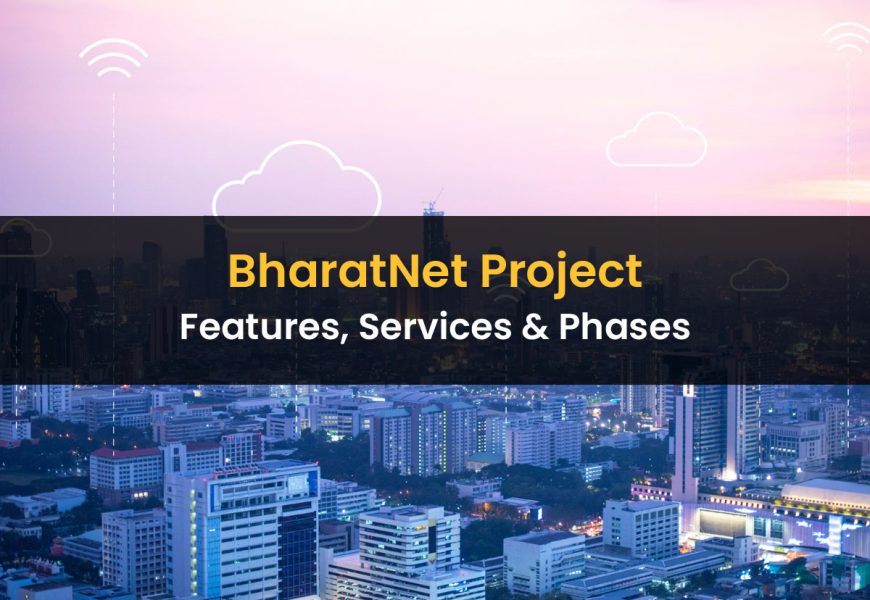BharatNet is one of the largest rural telecom projects globally, designed to provide broadband connectivity to all Gram Panchayats (approximately 250,000) across India. Launched to ensure non-discriminatory access to broadband for all telecom service providers, BharatNet facilitates services like e-health, e-education, and e-governance in rural and remote areas. The project was approved by the Union Cabinet on October 25, 2011, and is managed by Bharat Broadband Network Limited (BBNL), a Special Purpose Vehicle incorporated on February 25, 2012, under the Indian Companies Act 1956.
On April 30, 2016, the Telecom Commission sanctioned the implementation of BharatNet in three phases. As of May 27, 2024, the project successfully connected 212,778 Gram Panchayats, with 686,963 kilometers of Optical Fiber Cable (OFC). Additionally, 1,022,018 Fibre-To-The-Home (FTTH) connections have been established, and 104,574 Wi-Fi hotspots have been installed to ensure robust last-mile connectivity.
This article will cover all things important, its features, benefits, phases, and much more.
What is BharatNet Project?
BharatNet, also known as Bharat Broadband Network Limited (BBNL), is a central public sector undertaking established by the Department of Telecommunications under the Ministry of Communications, Government of India. Its mission is to create, manage, and operate the National Optical Fibre Network to deliver broadband connectivity of at least 100 Mbit/s to all 250,000 Gram Panchayats nationwide, encompassing nearly 625,000 villages. This initiative aims to enhance the middle layer of nationwide broadband internet infrastructure, supporting the Digital India vision.
Phase I of BharatNet, which connected 100,000 village councils and covered 300,000 villages, was completed by December 2017. Phase II is slated for completion by March 31, 2023, targeting the connection of the remaining 150,000 village councils and covering 325,000 villages across 16 states (as of July 2021). To ensure last-mile connectivity, a total of 700,000 Wi-Fi hotspots will be established, with 2 to 5 hotspots per Gram Panchayat and at least one hotspot per village. This will be achieved by connecting high-speed 4G base tower stations of commercial telecom operators to BharatNet. To support non-commercially viable Wi-Fi hotspots, the union government will provide a subsidy of ₹36 billion (equivalent to ₹50 billion or approximately US$610 million in 2023).
BharatNet stands as the world’s largest rural broadband connectivity program, developed under the Make in India initiative without the involvement of foreign companies. It serves as both an enabler and beneficiary of other significant government schemes, including Digital India, Make in India, the National e-Governance Plan, UMANG, Bharatmala, Sagarmala, Parvatmala, dedicated freight corridors, industrial corridors, UDAN-RCS, and the Amrit Bharat Station Scheme.
Objectives of the BharatNet Project
BharatNet aims to compete with private operators like Jio and Airtel by focusing on rural areas where these companies have less presence. The quality of service provided by BharatNet is crucial for attracting users in these regions. The project intends to connect all 640,000 villages across India with high-speed internet and ensure broadband connectivity to over 250,000 Gram Panchayats nationwide.
The government plans to deliver a minimum bandwidth of 100 Mbps at each Gram Panchayat, making online services accessible to everyone, particularly in rural areas. Similar to private telecom companies like Airtel and Jio, the revamped BharatNet model will collaborate with Village Level Entrepreneurs (VLEs) for implementing fiber connections. In this approach, the government will cover the cost of extending infrastructure to homes, while entrepreneurs will handle the maintenance and operation of these connections. This partnership will operate on a 50:50 revenue-sharing basis.
Features of BharatNet Project
The BharatNet Project is designed to provide internet connectivity in remote and rural areas of India. Launched under the Digital India program, it aims to transform India into a knowledge-driven economy and a digitally empowered society. Here are some key features of the project:
- Enhanced Connectivity: The project focuses on delivering high-speed internet to rural areas through optical fiber, ensuring affordable and reliable connectivity.
- Transparency: By improving the connectivity system, BharatNet promotes transparency and efficiency in the delivery of digital services.
- Broadband Access for All: The initiative aims to provide broadband connectivity to all families in rural areas, significantly easing daily life and access to information.
- Improved Living Standards: With better internet access, the standard of living in rural communities is expected to improve, providing new opportunities for economic and social development.
- Access to Online Services: Rural residents will be able to access a wide range of online services, from healthcare to government services, enhancing their overall quality of life.
- Educational Opportunities: Students in rural areas will benefit from the ability to attend online classes, which can help them achieve academic success and better prospects.
The BharatNet Project is a crucial step toward bridging the digital divide between urban and rural India, ensuring that everyone has the opportunity to participate in the digital age.
Services Under the BharatNet Project
The BharatNet Project provides connectivity to service providers such as ISPs, TSPs, LCOs, MSOs, and government agencies, enabling them to extend their services from block to Gram Panchayats (GPs). Serving as a middle-mile network, it facilitates the following key services:
Bandwidth Service
- Utilising Gigabit Passive Optical Network (GPON) technology, BharatNet offers both point-to-multipoint and point-to-point bandwidth from blocks to GPs.
- Bandwidth is provided at attractive and affordable prices to promote the digital ecosystem.
- Government agencies and service providers can connect to BharatNet at block locations to offer services to GPs, though they must use their technology to deliver these services to end customers.
Dark Fibre Service
- Bharat Broadband Network Limited (BBNL) offers dark fiber service on new cables laid between blocks and GPs, known as incremental cables.
- This service is available at 15,000 GPs, providing an affordable rate of Rs. 2,250 per fiber per annum per kilometer.
- Service providers can utilize this dark fiber to extend their reach and improve connectivity in rural areas.
How is BharatNet being Implemented?
The BharatNet Project is entirely funded by the Universal Service Obligation Fund (USOF), which was established to enhance telecom services in remote and rural areas of India. The project is being implemented in phases:
First Phase
The first phase aimed to provide broadband connectivity to 100,000 Gram Panchayats (GPs) by December 2017 through the installation of underground Optical Fibre Cable (OFC) lines. This phase has been completed, with Central Public Sector Undertakings (BSNL, PGCIL, and RailTel) leading the implementation. The existing fiber infrastructure of BSNL between blocks and GPs was utilized, and additional OFC was laid under the project. Currently, work is ongoing to connect new GPs not included initially.
Second Phase
The second phase, launched to connect all GPs in India by March 2019, employs various technologies, including fiber over power lines, radio, underground fiber, and satellite media. State participation was crucial for the success of this phase, which also introduced the use of OFC over electricity poles.
Using aerial OFC over electricity poles offers several advantages: faster implementation, easier maintenance, lower costs, and the utilization of existing power line infrastructure. Additionally, this phase proposes to provide last-mile connectivity to citizens by creating Wi-Fi hotspots in GPs.
Third Phase
From 2019 to 2023, BharatNet is focused on creating a future-proof, state-of-the-art network with a ring topology that includes fiber connections between districts and blocks to ensure redundancy. This phase aims to extend connectivity to every inhabited village beyond the Gram Panchayats (GPs) in 16 states, utilizing a Public-Private Partnership (PPP) model.
As of February 28, 2022, the implementation status of the BharatNet Project is as follows:
- Service Ready GPs: 172,361 GPs are now service ready, with 4,351 GPs connected via satellite and 168,010 GPs connected through Optical Fibre Cable (OFC).
- Wi-Fi Hotspots: Wi-Fi hotspots have been installed in 104,288 GPs.
- Broadband Connections: Approximately 213,834 Fibre-to-the-Home (FTTH) broadband connections have been provided.
- Dark Fibre: About 36,333 km of dark fiber has been leased.
- Bandwidth Leasing: Around 4,038 Gbps of bandwidth has been leased using the BharatNet network.
Challenges to the BharatNet Project
- Slow Progress and Implementation Delays: The BharatNet Project has experienced significant delays, progressing slower than anticipated. Despite government efforts, only about 194,000 of the targeted 640,000 villages have been connected so far, impeding the project’s goal of bridging the digital divide in rural areas.
- Infrastructure and Connectivity Issues: Difficult terrain, lack of proper roads, and logistical challenges have contributed to delays in connecting villages. These connectivity issues have resulted in poor service quality and intermittent internet access in some areas.
- Technical and Operational Issues: Technical challenges such as signal quality, bandwidth limitations, and network downtime have negatively impacted the overall user experience. Managing operations, maintenance, and complaint resolution decentralised, involving local entrepreneurs has proven complex and requires effective coordination.
- Competition from Private Operators: Private telecom operators like Jio and Airtel have established their network infrastructure and services in some rural areas, posing a challenge for BharatNet. To attract users, BharatNet must offer competitive pricing and ensure reliable service quality in the face of this competition.
Is There a Way Forward?
The BharatNet Project faces various technical, financial, operational, and awareness-related challenges. Overcoming these hurdles is critical for successfully achieving the project’s objective of extending digital connectivity to every corner of rural India.
Efforts must focus on expediting the implementation process by identifying and resolving bottlenecks. Streamlining infrastructure deployment and enhancing coordination among government agencies, local bodies, and private partners are essential steps.
Ensuring a consistent and sustainable flow of funds is paramount for the project’s success. Clear financial planning, effective allocation, and meticulous management are crucial to support the project’s expansion and maintenance initiatives.
Improving the quality of service is pivotal in attracting and retaining users in rural areas. Addressing technical challenges, maintaining consistent bandwidth, and minimising network downtime are key priorities.
FAQs on BharatNet Project
What is the old name of BharatNet?
Initially known as the National Optical Fibre Network (NOFN), the initiative was approved on October 25, 2011. It was later rebranded as BharatNet to extend optical fiber connectivity to all Gram Panchayats, covering nearly 625,000 villages in India.
What is the aim of BharatNet?
The BharatNet Project aims to provide broadband connectivity to rural India using optical fiber technology. It connects villages, Gram Panchayats, and individuals, enhancing access to e-services, online education, and more.
What is the cost of the BharatNet project?
The BharatNet project has an approved outlay of ₹1.39 lakh crore. This funding supports the goal of achieving last-mile connectivity across 6.4 lakh villages in India through involvement with village-level entrepreneurs for connectivity and maintenance.
What is the current status of BharatNet?
Currently, 207,592 Gram Panchayats are service-ready under the BharatNet Project, with 668,491 kilometers of optical fiber deployed nationwide. Over 766,619 Fiber-to-the-Home (FTTH) connections have been established across India.
What is the speed of BharatNet internet?
The Government of India, through the Department of Telecom, has set a minimum broadband speed of 100 Mbps for BharatNet. This strategic plan aims to provide high-speed internet connectivity via fiber optic cable to all 250,000 Gram Panchayats in India.















